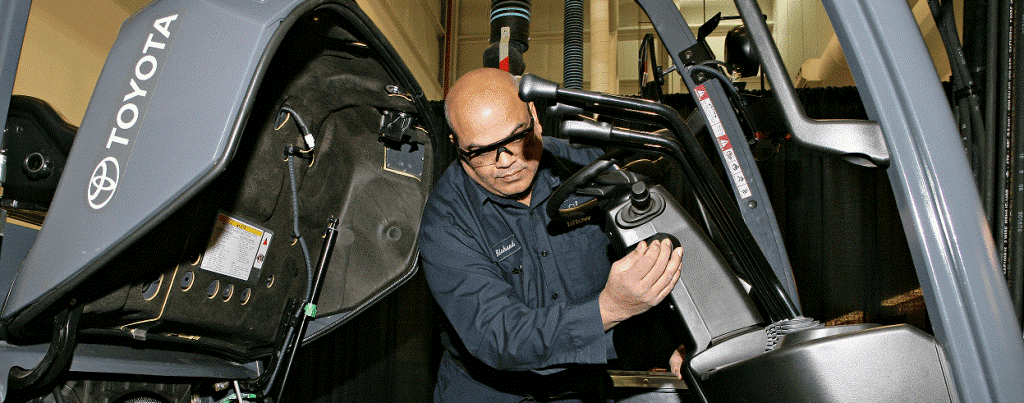

Forklifts are a common sight in many industries. Whether used in warehouses, manufacturing plants, retail applications or elsewhere, forklifts are crucial tools in the daily operations and supply chains of most businesses. Because of this frequent level of use, many operators and nearby pedestrians can become complacent regarding safety protocols. This complacency can have many ill effects, including asset damage, employee discipline, fines, injury, and even death.
According to the Operational Safety and Health Administration (OSHA), an average of 100 employees are killed each year in forklift accidents, and as many as 95,000 total forklift accidents occur on an annual basis. In many cases, these accidents are avoidable. While Toyota forklifts are carefully manufactured with safety top-of-mind, safety protocols must be followed correctly for operators and pedestrians to be protected.
The Importance of Inspection
Beyond behavioral causation, injuries and fatalities also stem from detectable equipment failure when employees do not properly inspect and assess equipment before use. Safety regulators, forklift manufacturers, and many companies encourage that forklifts be inspected before operating, but these inspections are often neglected or poorly documented. Safety is an obvious reason that these inspections should be conducted regularly, and so is compliance—thousands of dollars in fines could be levied based on failure to determine forklift safety prior to operation.
Protecting company reputation, finances, property, and lives against this sort of failure and related accidents typically requires only one measure be taken—pre-operation forklift inspections carried out according to a thorough checklist. In addition to the safety and compliance related aspects of regular forklift inspections, there is also a cost-savings component related to the proactive discovery of issues and predictive maintenance. Discovering problems, or festering problems, sooner helps limit and plan downtime and can be an easier, less expensive repair than a full-blown issue. Creating and adhering to a pre-operation inspection regiment is not inherently difficult, but it does take continuous corporate support and a high level of operator discipline.
Forklift Inspection: What Must You Do?
In its 29 CFR 1910.178 standard language, OSHA states that forklifts must be inspected either daily, or after each shift in cases where vehicles are in round-the-clock use. If problems are discovered, they must be reported and the forklift must be removed from service immediately. While there are no mandates in the standard as to precisely how the inspections must be conducted, there are suggested best practices readily available.
What Should Go Into a Forklift Daily Checklist?
If you do not have a pre-operational checklist for your forklifts established, do not worry—they are fairly intuitive. Manufacturers often provide sample checklists that are updated and customized as necessary. Referencing these directions are your best bet. If you wish to create your own checklist, though, the following are examples of checkpoints that should always be included in your daily forklift inspection:
Depending on the type of forklift you are using, there may be other propulsion-specific aspects to check:
Electric Forklifts Pre-operation Checklist
Here are a few items worth checking on your electric forklifts:
Use this Electric Forklifts Inspection Checklist to inform your own practice:
Internal Combustion Cushion and Internal Combustion Pneumatic Forklifts Pre-operation Checklist
Here are a few items worth checking on your internal combustion cushion and pneumatic forklifts:
Reach Trucks Pre-operations Checklist and Order Pickers Pre-operations Checklist
Here are a few items worth checking on your reach trucks and order pickers:
Protect Yourself, Your Employees, and Your Investment
Regularly WD Matthews services customers trucks and there is clearly no pre-shift inspection being performed. If this is your business, you should be concerned for several reasons. First, this is required by law, as stated previously. Secondly, the inspection will protect your employees and equipment from being run with defects. Remember that this is written in the operator’s manual and is a condition of proper use. If you are not performing pre-shift inspections, you could void the warranty. As a warranty administrator for several manufacturer’s WDM has seen this before. Finally, the pieces of equipment were made to run. You should start every day with starting the unit and running it up to temperature. Then utilize all the controls and features. Even if the unit is not run everyday it is important to perform this operational check. I have personally seen units with thousands of hours in better operational shape than ones with hundreds simply because it ran every day. It’s a small commitment to a large investment.